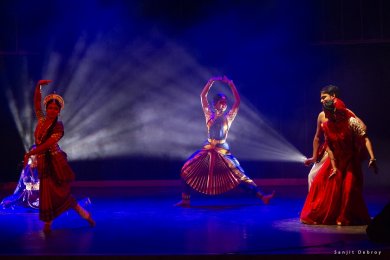
|   |

|   |
Amaiza's Dastaan E Dhadkan: Journey of life in dance form - Dr. Bhabani Dikshit e-mail: bdikgreen@gmail.com Photos: Sanjit Debroy October 17, 2018 The recently concluded dance performance, 'Dastaan E Dhadkan' by Amaiza dance group held at Stein Auditorium, India Habitat Centre, New Delhi, before a packed audience, was scintillating. Innovative choreography was the hallmark of the group presentation that kept the audience repeatedly applauding with every move, bhav, mudra and bhangi of the artistes. The dance style was a fusion of Odissi, Bharatanatyam and Kathak synthesized in harmony with the unique theme of journey of life: foetus to childhood, childhood to adolescence, adolescence to youth and youth to old and how in this journey of life, life comes in contact with other lives, compassion, dilemma, anxiety, anger, happiness, frustration, motivation, introspection and also comes in contact with the nature, the flora and fauna and the journey moves into eternity like the soul. All these elements were enacted with dance sequels to the utmost perfection amidst tak tak dhei narratives in every stage of life depicted by dancers in one of the dance forms. The story was held together by the narrator played by Bharatanatyam dancer Himanshu Srivastava.   The journey of life through the thinly demarcated sets of dances, symbolized the journey of rhythm that does not stop but continues even after the physical extinction. The rhythm is reflected as the soul. Five stages of life were portrayed by five dance sequences. Sunny Prakash (contemporary dance) exhibited signs and movements of an unborn child while being in a mother's womb. Sakshi Tandon, Anjali Munjal, Muskan and Nidhi Kakkar (Kathak) portrayed the unhindered freedom enjoyed during childhood through their dances. Nitisha Nanda and Snigdha Shikha Pattajoshi (Odissi) beautifully presented adolescent behavior representing the signs of growing up and expressed liberated joyous moods. Ankita Kaushik and Akanksha Rana performed the stages of vibrant youth through Bharatanatyam manifesting ambitions, anxieties and dilemmas of life and finally adulthood was performed by Anjali Munjal and Mohit Shridhar through Kathak dance where in symbolisms of love, marital bonds and discords are displayed with the subsequent onset of old age and death. Even after the cessation of physical life rhythm of life continues as the dance sequences vividly showed. This aspect all the dancers in unison presented through celebrations of continuation of life form by modes of colourful circular dances in rejoice and amidst beautiful sounds of Buddhist chanting: 'Om Mani Padme Hum.' The dance sequences representing various stages of life though comprehensively presented phase wise spectacularly well-rehearsed by the troupe, could have been further fine tuned keeping in mind the over-stretched theoretical elaborations. Narrations of Himanshu Srivastava were no doubt superb. With this event, another feather has been added to the brilliant choreography of Nitisha Nanda.  In an engaging conversation with this writer on the concept of Dastaan E Dhadkan, Nitisha Nanda elaborated on the production. She said Dhadkan is the pulsating heartbeat that flows life into our physical body, and the infinite life with a process of the journey of our soul. While the soul is thought to be on an unending journey, the heartbeat seemingly begins and ends with the life of our physical being. But is it really true? Does one heartbeat not bring to life several others, creating an unending concatenation of stories, extending to infinity? The journey always goes on; each times a new beginning, but never an end. That's why she said, Amaiza brought in Dastaan E Dhadkan, an eloquent dance story on the infinite journey called Life.  A story portrayed from the eyes of a heartbeat, the presentation talks about how life begins in our mother's womb, taking us through a phase of unexpected twists and turns. Moving out from there is the first connect with the outside world. Every object gathers attention, everything looks fascinating, and in the midst of endless questions we continue growing up, our heartbeat at a steady pace. We soon reach a stage where our own physical body catches our attention. We feel changes unknown to us before; we fight emotions we didn't know existed. Nitisha reiterated, as our heartbeat races faster, we discover ourselves, make friends for life and a fresh zeal to discover what next takes over. As the next phase ensues, the battle between the mind and heart takes over. As we try to stay focused, keeping our desires in control, we only move on to realize that only our heart can satisfy us and so begins a new urge for companionship. Life goes on and new struggles keep approaching, till we reach a stage where all our achievements suddenly hold no meaning and we thus start questioning our purpose. The beating heartbeat then looks back and makes us realize that whatever it is, it's all going to come back to us again, in another life. The heartbeat doesn't die, neither does the soul. The sooner we realize that it's all a game of rebirth and acceptance is the key, our lives wouldn't seem so complex and the path of enlightenment would be our only path, said Nitisha. Dr. Bhabani Dikshit is Managing Editor of World Focus based in New Delhi. |